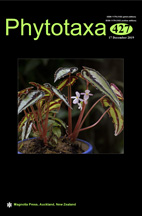Abstract
Two new species, Begonia dinhdui and B. bacmeensis are described from Vietnam. Begonia dinhdui is somewhat similar to B. austrovietnamica C.-I Peng, C.W. Lin, D.D. Nguyen & N.D. Truong, a limestone tuberous species also occurring in southern Vietnam. Both species have a periodically dormant habit and silvery variegated lamina, however, the new species differs in having a rhizomatous (vs. tuberous) rootstock, cymose (vs. racemose) inflorescence and 4-tepaled (vs. 6-tepaled) pistillate flower. Another new species, Begonia bacmeensis most closely resembles B. psilophylla Irmsch. in its stout rhizomatous rootstock, 4-tepaled staminate flower and 5-tepaled pistillate flower, but differs from the latter by having a strongly asymmetrical (vs. subsymmetric), lanceolate to oval-lanceolate (vs. ovate) lamina, tepals of staminate and pistillate flower pale green (vs. pink), ovary lateral wings surface verrucose or echinate (vs. nearly flat). Begonia dinhdui is currently known only from a single locality in Lâm Đồng Province while B. bacmeensis is rather common in Hà Giang Province.

